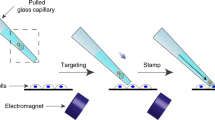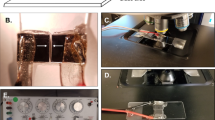Abstract
Single-cell engineering via virus based genetic manipulation allows the possibility of understanding of complex tissues. However, current delivery methods for the genetic engineering of single cells via viral transduction suffer from limitations that restrict their application. Here I present a protocol describing a precise technique which can be used for the targeted virus infection of single cells in a monolayer of cells that is optically accessible. The protocol, demonstrated here by stamping cultured Hela cells with lentiviruses (LVs), completes in a few minutes and allows stable transgene expression within a few days, at success rates approaching 80%.
Access this chapter
Tax calculation will be finalised at checkout
Purchases are for personal use only
Similar content being viewed by others
References
Hodzic E (2016) Single-cell analysis: advances and future perspectives. Bosn J Basic Med Sci 16:313–314
Di Carlo D, Tse HT, Gossett DR (2012) Introduction: why analyze single cells? Methods Mol Biol 853:1–10
Stuart T, Satija R (2019) Integrative single-cell analysis. Nat Rev Genet 20(5):257–272
Fugger L, Friese MA, Bell JI (2009) From genes to function: the next challenge to understanding multiple sclerosis. Nat Rev Immunol 9(6):408–417
Akhtar A et al (2011) A decade of molecular cell biology: achievements and challenges. Nat Rev Mol Cell Biol 12(10):669–674
Chari R, Church GM (2017) Beyond editing to writing large genomes. Nat Rev Genet 18(12):749–760
Lotze MT, Kost TA (2002) Viruses as gene delivery vectors: application to gene function, target validation, and assay development. Cancer Gene Ther 9(8):692–699
Wang D et al (2019) Adeno-associated virus vector as a platform for gene therapy delivery. Nat Rev Drug Discov 18(5):358–378
Belousova N et al (2002) Modulation of adenovirus vector tropism via incorporation of polypeptide ligands into the fiber protein. J Virol 76(17):8621–8631
Uchida E et al (2007) Optimization of the virus concentration method using polyethyleneimine-conjugated magnetic beads and its application to the detection of human hepatitis A, B and C viruses. J Virol Methods 143(1):95–103
Walther W, Stein U (1996) Cell type specific and inducible promoters for vectors in gene therapy as an approach for cell targeting. J Mol Med (Berl) 74(7):379–392
Schubert R et al (2019) Magnetically guided virus stamping for the targeted infection of single cells or groups of cells. Nat Protoc 14(11):3205–3219
Schubert R et al (2018) Virus stamping for targeted single-cell infection in vitro and in vivo. Nat Biotechnol 36(1):81–88
Judkewitz B et al (2009) Targeted single-cell electroporation of mammalian neurons in vivo. Nat Protoc 4(6):862–869
Kitamura K et al (2008) Targeted patch-clamp recordings and single-cell electroporation of unlabeled neurons in vivo. Nat Methods 5(1):61–67
Acknowledgments
This study was supported by a Burroughs Wellcome Fund grant (ID #1018793 to R.S.)
Competing financial interests: The author declares competing financial interests. The author applied for a patent related to the virus stamping approach.
Author information
Authors and Affiliations
Editor information
Editors and Affiliations
Rights and permissions
Copyright information
© 2021 Springer Science+Business Media, LLC, part of Springer Nature
About this protocol
Cite this protocol
Schubert, R. (2021). Magnetically Single-Cell Virus Stamping. In: Kojima, R. (eds) Mammalian Cell Engineering. Methods in Molecular Biology, vol 2312. Humana, New York, NY. https://doi.org/10.1007/978-1-0716-1441-9_20
Download citation
DOI: https://doi.org/10.1007/978-1-0716-1441-9_20
Published:
Publisher Name: Humana, New York, NY
Print ISBN: 978-1-0716-1440-2
Online ISBN: 978-1-0716-1441-9
eBook Packages: Springer Protocols




